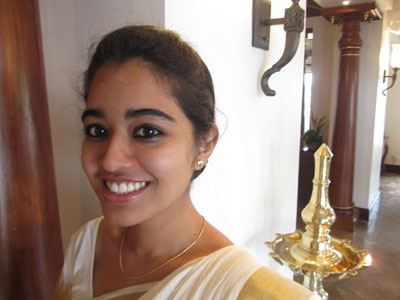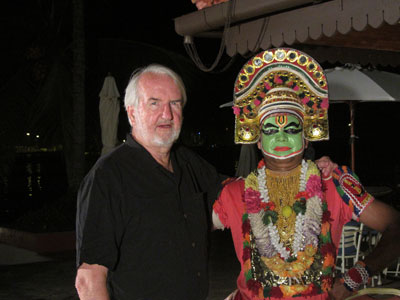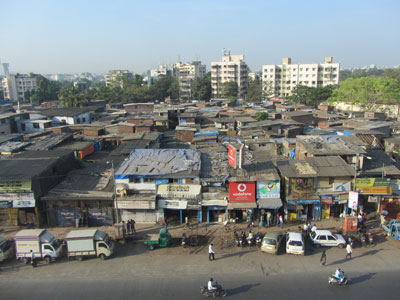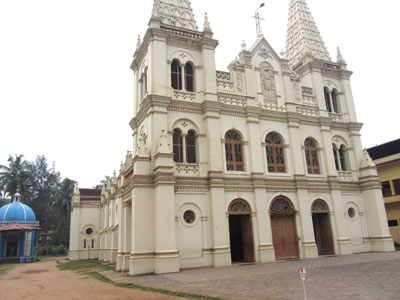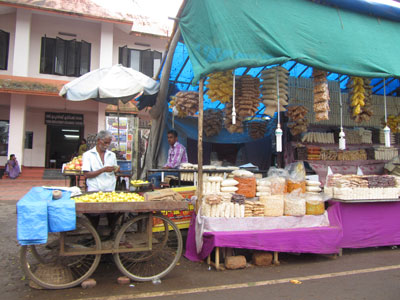Exploring southern India and the backwaters of Kerala
This article appears on page 32 of the February 2013 issue.
by Sean Sullivan, Darien, CT
My wife, Rita, and I decided to celebrate our 15th wedding anniversary in India. We had fallen in love with the country on a 3-week visit in 2004. On that trip we visited the north, traveling to New Delhi, Mumbai, Jaipur, Agra and Varanasi, among other cities.
I had also been to India in 1976, backpacking my way solo from Calcutta to the Pakistan border as I returned to the States from my years with the Peace Corps in Africa.
The India I visited then was not the India we visited in December 2011. Of course, 30-plus years ago I was comfortable staying in youth hostels with 100 other itinerants. Now my preference — and my wife’s from birth — was staying in sumptuous hotels, like those of Taj, Oberoi and Leela.
This time we decided to focus on southern India, specifically one of its southernmost states, Kerala.
Making plans
When it comes to planning trips abroad, I’m a research junkie. My wife works, but I’m retired, so it’s my job to design the best trip at the best price at the best time of the year. Four months before departure, I had my assignment: find interesting places to visit, preferably with world-class hotels.
I consulted the usual suspects: guidebooks, friends who had visited and TripAdvisor.com. My thought was we’d spend an entire two weeks working our way by car and driver, bus and train from southern Kerala into the mountains of northern Kerala. That was the plan, but I didn’t stick to it.
My wife happened upon an article in The Wall Street Journal about travel consultancies. Three were detailed, with a company called Jetsetter (New York, NY; 877/573-8872) being the highest rated by The Journal’s writer.
I called and was told that for $200 I would be assigned my very own “travel expert,” someone intimately familiar with the area being visited, who would offer advice and respond to my plans. Heck, $200 was nothing compared to what I anticipated we’d spend on the trip, so I agreed.
When I laid out my proposed itinerary, the first thing expert Anjali, who had been in the hospitality business in Kerala, said was, “You don’t need two weeks to taste Kerala. A week will do.”
‘Could she be right?’ I wondered. As I stepped up my research, I discovered that, indeed, she was. Of course, there’s never enough time to really get into a place, but, for a taste, yes, one week should be sufficient.
So I focused my research on the very best places in Kerala, frequently bouncing my plans off Anjali. We changed plans at least a half dozen times, and Jetsetter’s travel coordinator Charlotte was incredibly patient and efficient in altering our itinerary.
We used frequent-flyer points to get from New York to Mumbai via London on British Airways. I flew first class because I am tall; Rita flew business class because she’s short. We each had sleeper beds that fit our respective sizes.
We arrived in Mumbai about midnight, and, since we were leaving for Trivandrum — 2½ hours to the south — early the next morning, I had booked a basic, reasonably priced room at Hotel Suba International for the night. The hotel, about a mile from the airport, was supposed to provide transportation, but there was a mix-up and we had to take a taxi.
The hotel, which was fine for a quick and inexpensive stay ($110 per night, airport shuttle and bad breakfast included), did transport us to the airport early the next morning.
To Trivandrum
We arrived in Trivandrum at about 10 a.m. via Jet Airways and were met by a driver from our hotel, The Leela, who was carrying a sign saying “Welcome Rita Sullivan.” Hey, how about me? I planned the trip!
The Leela was in Kovalam, about 15 miles south of the airport. The grounds of the hotel were fabulous, befitting the fact that it once was a summer palace for the kings of Kerala. The large, luxurious lobby was equally impressive, as was the nearby infinity pool. We anticipated a room to match.
We were bundled into a golf cart and taken down the road to, sadly, the “garden view” section. I checked out the room and what looked like a municipal pool in the area and immediately called the manager. For 1,500 rupees ($28) tacked onto the 9,000 rupees ($166) we were paying, we ended up back among the elite. (The manager said the normal upgrade is 3,000 extra rupees.)
The hotel staff was great. The restaurant near the pool featured pizza cooked in an honest-to-goodness pizza oven. Dying to try an Indian pizza, I ordered a pizza margherita, which turned out to be basically a hunk of cheese on dough with a smattering of tomato sauce.
I ate about half the pizza. When the waiter asked if anything was wrong with it, I said, “No,” but the pizza chef came over. I told him that I was from the New York area, which made me both a connoisseur of pizza and perhaps a bit obnoxious. He said he was anxious to learn how to make the pizza better, so I told him: “Less cheese, more sauce, longer oven time.”
He said he would have one for me the next day. Since we were staying only the night, I had told him that his offer was nice but unnecessary, but as we were leaving by car later the next morning, out he came with a boxed pizza, which we ate on the road. It was delicious!
Our next destination was Kerala’s famous backwaters, hundreds of square miles of rivers, tidal basins, estuaries, streams, inlets, bays, coves and creeks all emptying into the Arabian Sea.
Earlier I had inspected train and bus schedules for the trip north to Kottayam and concluded that public transportation meant hours on the road, zigging here, zagging there. I love negotiating, so my next plan involved heavy negotiations with local taxi drivers. However, every one of them failed to succumb to my charm — and my price — so, though I felt like a sellout, we opted for a comfortable car and driver (about $200) from our hotel.
Homestay
Most travelers, local and international, choose to experience the backwaters of Kerala via a houseboat. There are all sorts of houseboats, from deluxe to basic, some holding just two or three guests and some holding many more.
We preferred to get closer to the real India, so we chose a “homestay” at Philipkutty’s Farm, a working farm on reclaimed land in the middle of the backwater.
We were dropped in a clearing on the shore of Lake Vembanad, wondering how in the world the people from the farm would know we were close. Before long, we saw a thin man with a long pole propelling a craft looking very much like a large dugout canoe coming to get us. He took our bags, and soon we were being greeted by the farm’s owner, Anu, a widow who lives on the farm with her two children and mother-in-law.
The farm can accommodate up to 12 people in six cottages. The cottages were charming and comfortable, with a separate bathroom and vigorous (and effective) fans in place of air-conditioning.
The cost per day, including three meals, a farm tour and a brief sunset cruise, was 9,500 rupees for two people.
The farm featured wonderful organic food prepared by Anu’s mother-in-law and her staff. Vegetables and fruits came right from the garden and fish directly from the sea — spicy and delicious! Meals were served family style at a large, round table, where Anu interacted with the guests.
It turned out that, for us (though perhaps not everyone), the choice of farm over houseboat was correct. I feel trapped on a boat, no matter how big and comfortable it might be, and trapped we would have been if we had stayed aboard a houseboat. All houseboats must remain docked at the water’s edge from 6 p.m. to 8 a.m. each day, meaning there is nothing to do or see for 14 hours.
I felt that the backwaters, themselves, weren’t all that interesting to look at. There was some bird life but not much, and the terrain didn’t vary — miles and miles of water and not a drop to drink, as we discovered on a 2-hour excursion arranged by Anu.
We were awakened each morning by the Muslim call to prayer emanating from a mosque across the water. On our second morning, we were “poled” across the water to a small village — really just a few dozen one- or two-room shelters on either side of a dirt road — to stretch our legs. We immediately ran into a group of people washing small, mussel-like shellfish. Steps ahead were women carrying the clean shells in baskets, first weighing them and then dumping them in the back of a truck. Back and forth they went.
We were told that the meat had been eaten previously and the shells were to be ground up and used as a base for paint.
On the road again
Two days later we were on the road again, this time heading north to tea plantation country. I calculated that the trip into the range of mountains called the Western Ghats and to its lively, sprawling main town of Munnar would take three to 3½ hours. Ha!
The road, as curvy as Marilyn Monroe, rose 5,000 feet and more above sea level, taking us into a wet and misty microenvironment that was green and lush. After 5½ hours of dodging trucks, cars, bikes, motorbikes, motorcycles, motor rickshaws, goats, adults, kids and even monkeys, we finally arrived.
We stayed at The Windermere Estate, a few miles from Munnar, in a large cottage with a terrace that offered an amazing view of the mountains, valleys and the beautiful greens of the tea plantations that seemed to cling to every inch of the hills. (The cost was INR11,500 a night, including breakfast, tea and a plantation trek.)
Windermere proved to be as impersonal a place as Phillipkutty’s Farm was personal, though the staff was fine and the locale beautiful. We toured the area late on the afternoon of our arrival, getting a bird’s-eye view of the diverse flora and fauna, including cardamom and nutmeg trees and spectacular poinsettia that were the size of rhododendrons back home.
That evening we had a very nice meal (total cost, INR700, or $12.74) consisting of chickpeas, cauliflower, fish cakes and a small chicken, with a delicious bread pudding for dessert followed by, naturally, tea (a masala chai), which was delectable.
The following day we took a taxi into Munnar. Our first stop was the Tea Museum, the highlight of which was a step-by-step demonstration of how a simple green leaf becomes the delicious brew consumed throughout the world. Naturally, we bought some tea to share with the folks back home.
Our second stop was a home for disabled children, where we planned to buy some of the handicrafts that provide support for the facility. Unfortunately, the school was closed that day, so we returned to downtown Munnar and its high-energy chaos — something I particularly love, perhaps because I am the oldest of 10 children and grew up in chaos. It felt like home!
Our driver insisted we visit Munnar’s Catholic church, which we were happy to do. It’s noteworthy that Kerala, of all places in India, has the largest contingent of Christians, a result of the area’s colonization by the Portuguese. More importantly, despite headlines in the Western press about strife between the different religions, we simply saw none. On the contrary, the different groups — Christians, Muslims, Hindus — seemed to get along extremely well. I mentioned this to a number of drivers, and they all said, “No problem. No problem at all.”
One other noteworthy item — the only beggar we observed in India was on the steps leading to the church.
If there were a need anywhere for people to beg, it was in the very small village located smack in the middle of the plantations just a few hundred yards from Windermere. This town of perhaps fewer than 100 souls was exceptionally poor, with garbage strewn about its two or three dirt alleys (I can’t even call them streets), but no one asked for anything.
In spite of the obvious poverty, the children were clean, energetic and beautiful. The one jarring element was the pretty, colorful Anglican church that sat in the middle of the, literally, dirt-poor town.
On to Cochin
The next day we were prepared for a 5-hour drive to Cochin (Kochi), on the west coast of Kerala. However, we had to leave at 4:30 a.m. to outrun a planned strike that would close the roads at 6:30, motivating our driver to prove he was as skillful as any Indianapolis 500 winner. We roared down the mountain, negotiating blind curves and precipitous drops like they didn’t exist.
I started out seated next to the driver, but, terrified, I said I wanted to get in the back. I did and found that the seat belt was broken, so I just closed my eyes and prayed. We ended up in Cochin in just over three hours!
Our hotel, the Vivanta by Taj Malabar (INR12,500 per night, with breakfast), was grand. Located on an island on the edge of the Arabian Sea, it had a staff that was second to none and a large infinity pool snuggled next to the ocean. Our top-floor room had a terrace offering views over the sea and out to the town of Fort Cochin and the busy port.
We ate breakfast and lunch at the hotel — both delicious — then took a 15-minute ferry ride to Fort Cochin, a place full of history, dating back nearly to the origins of colonialism.
An auto rickshaw took us to the Dutch Palace, the old seat of government first for the Portuguese and then the Dutch (who were supplanted, in turn, by the British). The palace, built in 1555 in traditional Kerala style, today is noted for its portraits of Cochin rajas and other notables and its many interesting mythological Hindu murals.
On our return to the hotel, we got on the wrong ferry. Twice. We felt like “Charlie on the MTA”!
Eventually, we made it back and were treated to drinks and hors d’oeuvres by the gracious manager of the hotel, followed by a romantic waterside dinner, during which we savored Indian lamb stew and a spectacular sunset.
The next day we skipped the ferry and hired a driver from the hotel to lead us on a tour of Fort Cochin. We visited the sparse church of St. Francis of Assisi, where Vasco da Gama was originally buried, then went on to see the so-called Chinese fishing nets. These are giant nets that are dipped into the water from shore, then, using stone levers, yanked out with (hopefully) the catch of the day.
We were asked if we wanted to participate, so we grabbed the thick ropes tied to the stones and hoisted the nets from the sea. Our catch of the day? Some kind of sea urchin no bigger than my thumb. So much for our help.
Reflection
So was a week enough for a taste of Kerala? A taste, yes, but not a full meal. Still, it was marvelous. Kerala is one of the more traditional states of India. Traditions such as arranged marriage still predominate. The women wear the most beautiful and colorful saris in the country, and we found the people to be warm and welcoming.
So many people underestimate the beauty and fascination of India. When we returned to the States after another week in India tracking tigers in the wild and staying at our favorite hotel, the Taj Mahal Palace in Mumbai, the Customs agent at JFK Airport looked at our passport and commented, “Why India? Haiti is closer if you were looking for poverty.”
He said it good-naturedly, but he reflected a common misunderstanding of that booming, complex, alluring, rich and poor country, the second-most populous in the world. For those misguided individuals, it is, sadly, their loss. For ourselves, we’ll go back to Kerala someday and stay longer!


